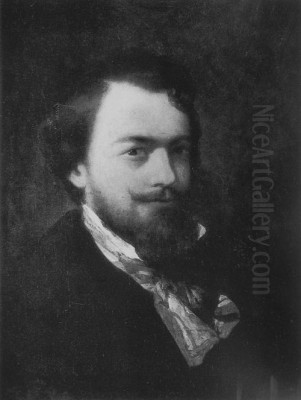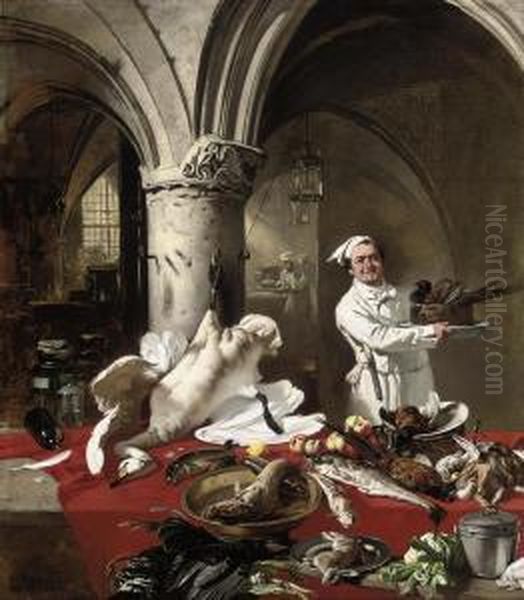
Charles Hoguet stands as a significant figure in 19th-century German art, a painter and lithographer whose career navigated the currents of Romanticism and the burgeoning interest in realistic landscape depiction. Born in Berlin in 1821 and passing away in the same city in 1870, Hoguet developed a distinctive style, particularly renowned for his evocative marine paintings and atmospheric landscapes, earning him considerable recognition during his lifetime. His artistic journey reflects the interplay between the established traditions of his native Prussia and the vibrant innovations emanating from Paris, the undisputed art capital of the era.
Early Life and Artistic Beginnings in Berlin
Charles Hoguet's life began in Berlin on November 21, 1821. His initial artistic training took place in his hometown under the guidance of Wilhelm August Christian Leopold Krause. Krause was primarily known as a marine painter, and this early exposure likely instilled in Hoguet a foundational interest in seascapes and the dynamic qualities of water and sky, themes that would become central to his oeuvre. Berlin, during Hoguet's formative years, was a city fostering its own artistic identity within the broader context of German Romanticism, a movement that emphasized emotion, individualism, and a profound connection with the natural world. Krause's studio provided Hoguet not only with technical skills in painting but also in lithography, a medium he would continue to utilize.
The Parisian Experience: Broadening Horizons
Seeking to expand his artistic education and immerse himself in contemporary trends, Hoguet traveled to Paris in 1839. This move was pivotal, placing him at the heart of European artistic ferment. In Paris, he sought instruction from prominent figures, notably Eugène Isabey and Eugène Ciceri. Isabey, in particular, was a highly respected painter of marine subjects and historical scenes, known for his dramatic compositions and fluid brushwork, often associated with the Romantic movement. Studying with Isabey undoubtedly refined Hoguet's approach to seascapes and exposed him to French Romantic sensibilities.

The Paris Hoguet experienced was a crucible of artistic ideas. While the influence of Romantic giants like Eugène Delacroix and Théodore Géricault still resonated, the landscape painters associated with the Barbizon School, such as Jean-Baptiste-Camille Corot, Théodore Rousseau, and Charles-François Daubigny, were gaining prominence. These artists advocated for painting directly from nature (en plein air) and brought a new level of naturalism and atmospheric sensitivity to landscape art. Though Hoguet's style retained distinct characteristics, his time in Paris enriched his palette, technique, and understanding of light and atmosphere.
Travels and Artistic Development
Hoguet's pursuit of subject matter and inspiration was not confined to studios. He became an avid traveler, undertaking sketching trips across various parts of Europe. His journeys took him to England, the Netherlands, Belgium, and significantly, to the coast of Normandy. These regions offered diverse landscapes that fueled his creativity. The Dutch landscape, with its windmills and flat horizons under expansive skies, clearly captivated him, echoing the works of 17th-century Dutch masters like Jacob van Ruisdael, whose influence can often be detected in Northern European landscape traditions.
Normandy's dramatic coastline, a popular destination for artists throughout the 19th century, provided ample material for his marine paintings, allowing him to study the effects of weather on the sea and shore. During some of his travels, he was accompanied by fellow German artist Eduard Hildebrandt, another painter known for his extensive travels and landscape views. These excursions were crucial for gathering sketches and impressions that would later be developed into finished paintings in his studio, imbued with the memories and emotions of the places he visited.
Artistic Style: Romanticism, Realism, and the "Raphael of the Windmills"
Charles Hoguet's mature style is a compelling blend of Romantic sensibility and keen observation. He excelled in capturing the mood and atmosphere of a scene, particularly evident in his depictions of stormy seas and dramatic skies. His ability to render the transient effects of light and weather was remarkable, lending his works a sense of immediacy and emotional depth characteristic of Romanticism. He wasn't merely documenting landscapes; he was interpreting their spirit.
His skill was widely recognized, leading to the somewhat unusual nickname "Raphael of the Windmills." While perhaps hyperbolic, this moniker suggests an appreciation for his technical mastery and perhaps a certain grace or idealization he brought to this common subject, elevating it beyond mere topography. His paintings often feature a high degree of technical proficiency and are rich in detail, demonstrating careful study of natural forms, textures, and light. This attention to detail aligns with aspects of Realism, even when the overall mood remains Romantic.
Hoguet's brushwork could be both precise and fluid, adapting to the subject matter. Whether depicting the turbulent waves of a storm-tossed sea, the intricate structure of a windmill, or the quietude of a pastoral scene, his technique served the expressive purpose of the painting. He masterfully conveyed the dampness of sea air, the solidity of rocky coasts, and the play of sunlight through clouds.
Key Themes and Subjects
Throughout his career, Hoguet focused primarily on landscape and marine painting. Seascapes were a recurring and dominant theme, ranging from tranquil coastal views to dramatic shipwrecks and stormy weather, such as the evocative The Wrecked Ship of the Merchant. These works allowed him to explore the power and majesty of nature, a core tenet of Romanticism.
Windmills became almost a signature motif, appearing frequently in his Dutch and North German landscapes. Works like The Last Windmill on Montmartre, likely painted during or inspired by his time in Paris, show his interest extended even to remnants of rural life within urbanizing environments. He depicted these structures not just as picturesque elements but often as symbols of endurance or a vanishing way of life, set against expressive skies.
Rural landscapes, often populated with figures, also formed a significant part of his output. Paintings like Shepherds and their Flock Resting under Trees (1868) showcase his ability to integrate figures naturally into the landscape, creating pastoral scenes imbued with tranquility. Other works, such as Preparing the Feast and Fishermen's Lunch, incorporate genre elements, telling small stories of everyday life within a natural setting. His Beach Landscape with Fishermen (c. 1850) combines his interest in coastal scenery with human activity.
Return to Berlin and Recognition
After his formative years abroad, Hoguet returned to Berlin, where he established himself as a prominent artist. He was highly prolific, estimating himself that he created around 500 paintings over his career. His work found favour with collectors and institutions in Prussia and beyond. His connection to both German and French artistic traditions likely gave his work a broad appeal.
His standing in the Berlin art world was formally recognized in 1869 when he became a member of the prestigious Berlin Academy of Arts. Membership signified official approval and placed him among the leading artists of the Prussian capital, alongside figures like the renowned realist Adolph Menzel, although their styles differed significantly. Hoguet also achieved success in exhibitions, winning a gold medal for a work titled Felsige Küstenpartie mit Staffage (Rocky Coastal Scene with Figures), which may be the same painting known in English as Beach Landscape with Fishermen. This award further cemented his reputation.
Historical Context: German and French Art in the Mid-19th Century
Hoguet worked during a dynamic period in European art. German art in the 19th century, while initially looking towards France, developed its own trajectories. German Romanticism, exemplified earlier by artists like Caspar David Friedrich, had a strong philosophical and emotional underpinning, often exploring themes of spirituality, nationalism, and the sublime power of nature. While Hoguet shared the Romantic interest in nature and atmosphere, his style was generally less overtly symbolic or melancholic than Friedrich's, perhaps tempered by French influences and a greater interest in observable detail.
Meanwhile, French art underwent rapid transformations. The Romanticism of Delacroix gave way to the Realism of Gustave Courbet and Jean-François Millet, who focused on unidealized depictions of contemporary life and labor. The Barbizon School painters, whom Hoguet would have encountered, bridged Romantic landscape traditions with a more direct, naturalistic approach. By the end of Hoguet's life, Impressionism was dawning in France, pushing landscape painting towards an even greater focus on light, color, and fleeting moments, pioneered by artists like Claude Monet and Camille Pissarro. Hoguet's work, therefore, sits interestingly between the established Romantic landscape tradition and the emerging trends towards Realism, primarily rooted in the German context but informed by his French experiences.
Legacy, Market, and Collections
Charles Hoguet's legacy rests on his significant contribution to German landscape and marine painting in the mid-19th century. He successfully synthesized elements from German Romanticism and French landscape traditions, creating works admired for their technical skill, atmospheric depth, and evocative portrayal of nature, particularly the sea and coastal environments. He remains a respected figure within the context of 19th-century German art.
His works continue to appear on the art market, though perhaps not as frequently or at the stratospheric prices of the biggest names of the era. Nonetheless, strong examples command respectable sums, as evidenced by a reported sale price of €35,750 at the Achenbach Art Auction XXL in 2015, indicating continued collector interest.
Hoguet's paintings are held in various public collections, confirming their historical and artistic importance. Notable examples include Shepherds and their Flock Resting under Trees (1868) at the Virginia Museum of Fine Arts (VMFA) in the United States, and Beach Landscape with Fishermen (c. 1850) in the Gettysburg College Fine Arts Collection. His works are also undoubtedly present in German museums, particularly in Berlin, given his long association with the city and its Academy. These institutional holdings ensure that his art remains accessible for study and appreciation.
Conclusion
Charles Hoguet carved a distinct path through the complex artistic landscape of the 19th century. As a German painter deeply influenced by Romanticism yet responsive to the currents of French art and the growing interest in naturalistic depiction, he created a body of work celebrated for its atmospheric power and technical finesse. His evocative seascapes, dramatic skies, and sensitively rendered landscapes, especially his famed windmills, capture a specific vision of Northern European nature. Bridging national traditions and artistic movements, Hoguet remains an important figure for understanding the richness and diversity of German art during a period of significant transformation, a skilled interpreter of the enduring dialogue between humanity and the natural world.